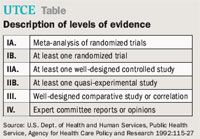Article
Updated guidelines for the management of ureteral calculi
This article provides an overview of the 2007 EAU-AUA Nephrolithiasis Guidelines.

Key Points

The American Urological Association Nephrolithiasis Guidelines Panel released its first set of ureteral stone guidelines in 1997.1 The panel reviewed all the available literature for the management of ureterolithiasis, summarizing the results and providing practice policy recommendations. After reviewing 1,698 articles, the panel used 327 articles from English-language, peer-reviewed journals that had adequate methods and data as the source of the 1997 guidelines.

The panel's conclusions in 1997 were that most ureteral calculi pass spontaneously. Those that do not can be treated with either shock wave lithotripsy or ureteroscopy. Open surgery was identified as an acceptable salvage procedure or option in uncommon circumstances, but was not to be used as a first-line treatment. Blind basket extraction was not recommended as an acceptable approach for ureteral calculi.
While the 1997 document provided useful recommendations for management of ureteral calculi, significant technological changes in shock wave lithotripsy, endoscope design, intracorporeal lithotripsy techniques, and laparoscopic expertise have occurred within the past 5 to 10 years. Therefore, in December 2007, the American Urological Association formulated a joint effort with the European Association of Urology to provide the first set of internationally endorsed guidelines, taking into account the myriad changes introduced in ureteral stone management since 1997.2
This article provides an overview of the 2007 EAU-AUA Nephrolithiasis Guidelines with an emphasis on treatment advances over the past decade, then summarizes the standards, recommendations, and options outlined in the updated guidelines.
2007 guidelines: Overview
The joint EAU-AUA Nephrolithiasis Guidelines Panel performed a thorough review of the English-speaking literature published since 1997, along with a comprehensive analysis of the data. The 2007 panel reported that SWL and URS remain the two primary treatment modalities for the management of symptomatic ureteral calculi. Introduction of medical expulsive therapy to facilitate spontaneous stone passage and laparoscopic ureterolithotomy also were extensively reviewed in the new document.
Among major changes in ureteral stone management since the publication of the 1997 guidelines document are significant improvements in ureteroscopic technology. Noteworthy advances in endoscope size, flexibility, working channels, and optics have made ureteroscopy simpler, safer, and more efficient. New ancillary devices, such as improved baskets and combination guide wires, have made the urologist's approach to ureteral stones safer.
Beyond baskets and wires, "backstop" tools (ie, the Stone Cone [Boston Scientific, Natick, MA], NTrap [Cook Urological, Bloomington, IN], and Accordian [PercSys, Palo Alto, CA]) are used with increasing frequency to prevent proximal stone migration during ureteroscopic procedures. The addition of ureteral access sheaths now allows rapid introduction of flexible ureteroscopes to manage both mid-and proximal ureteral calculi. Routine use of these ureteral access sheaths permits easier stone extraction with repeat ureteroscopic insertion, while protecting the ureter and ureteral orifice.
The other significant advance in ureteroscopic stone management has been the routine use of holmium laser stone fragmentation. Although it was available at the time of the 1997 guidelines, the holmium laser has become more affordable and its use more widely disseminated, making it the ideal tool for intracorporeal lithotripsy.
The joint AUA-EAU panel reviewed 348 relevant articles published between 1996 and 2006. Articles were excluded if they had been included in the 1997 guidelines, lacked useful data on outcomes of interest, or combined data on renal and ureteral stone treatment. Furthermore, review articles, salvage therapies, and archaic treatments were excluded from review. A total of 244 papers were abstracted and the data statistically analyzed.
The treatment methods assessed by the 2007 guidelines panel did not include blind basket extraction. However, medical expulsive therapy and laparoscopy were added to the treatment options. Again, an analysis of stone-free rates, spontaneous stone passage, procedures per patient, need for secondary intervention, and acute and long-term complications was performed. Outcome tables were generated, and confidence profiles were created using Bayesian analysis. Random effects were included and analyzed using a hierarchical model. The stone-free rate was determined to be the most quantifiable and meaningful measure of "successful" treatment. It must be noted, however, that many of the studies assessed stone-free rates with standard abdominal x-rays. This limitation was likely to lead to overestimation in the stone-free data.

Based on the literature review and analysis, the following standards, recommendations, and options were agreed upon. These consensus statements are summarized with brief discussions of the issues.





